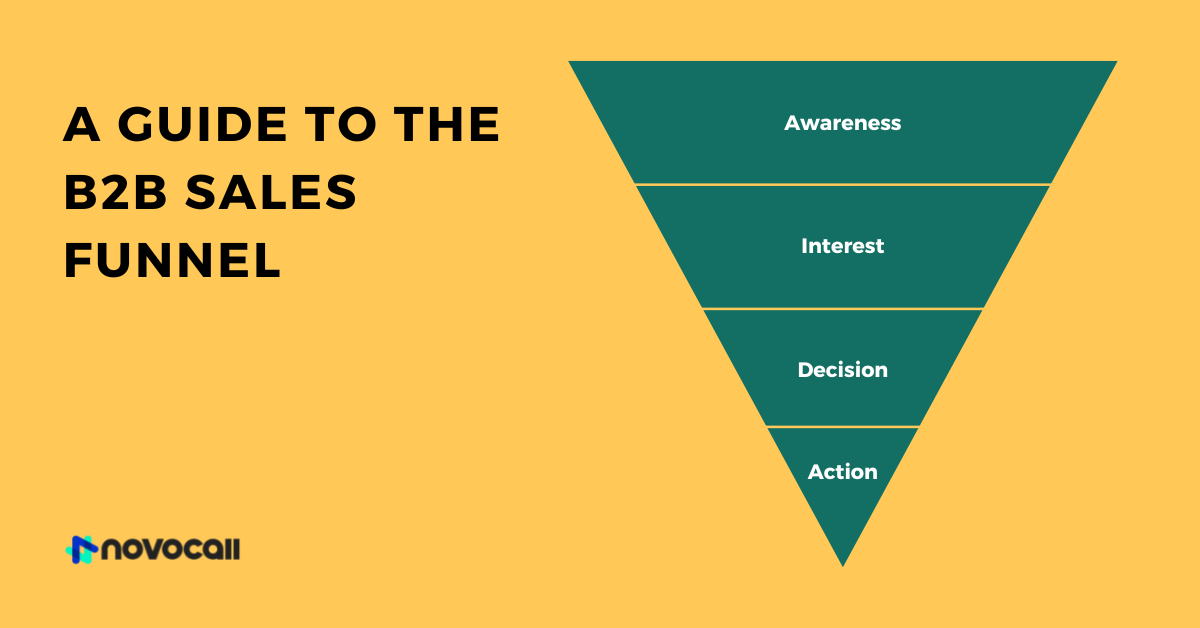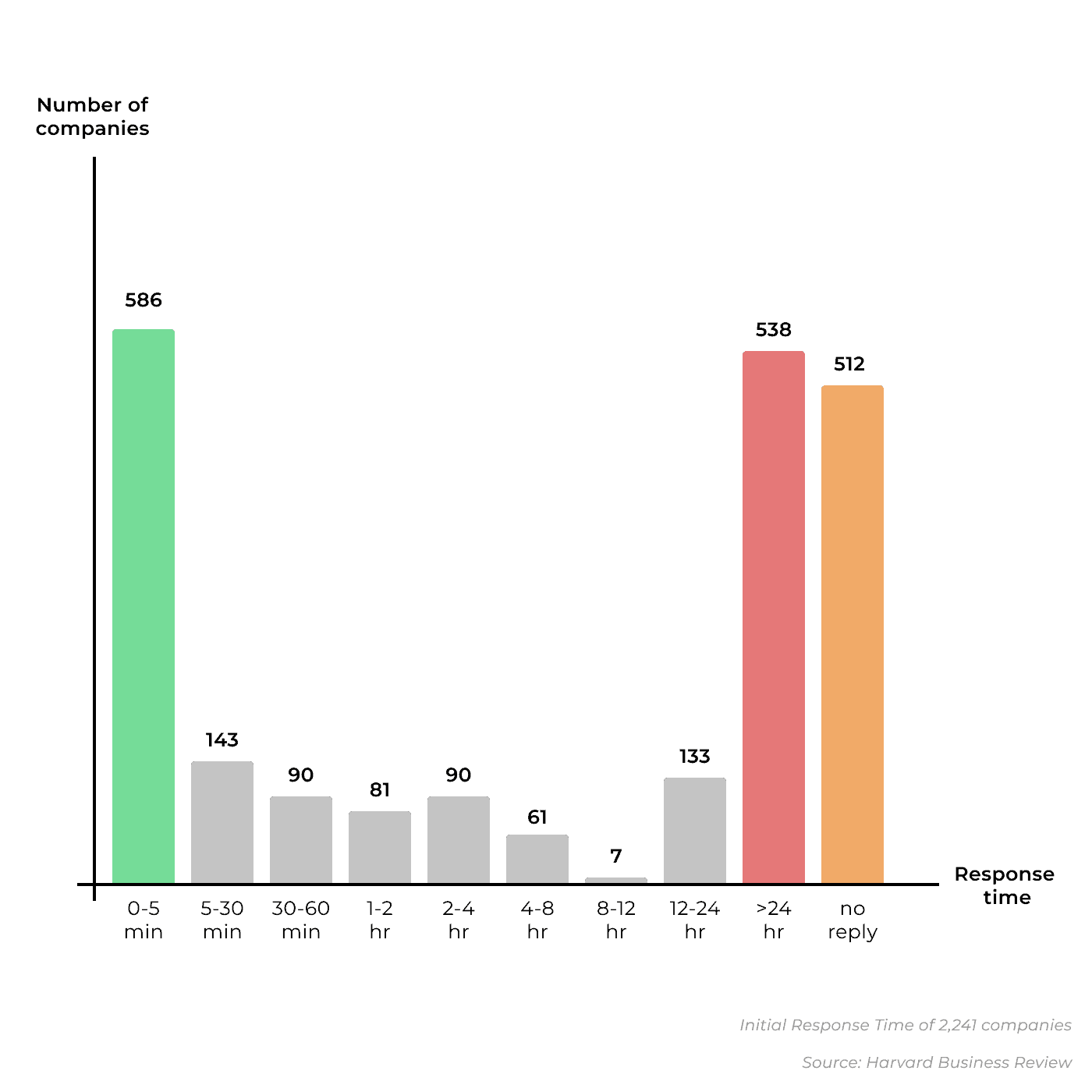


Start driving better conversations.
Novocall will be your new favorite business phone system.


Content Writer
Responding quickly to your leads boosts your sales, builds your credibility, and most importantly — improves customer satisfaction.
Unfortunately, many businesses still disregard the importance of responding to leads. In fact, a study found that 58% of companies don’t follow up with their leads.

To add to that, 24% of companies that actually do respond take over 24 hours to respond to their leads! This is unacceptable — imagine waiting for a day just for a reply. 😠

Well, on that note, you’re probably here because you’re looking for some solutions on how you can manage your lead response time.
Let’s dive right into the 7 best practices for lead response management so you can effectively respond to your leads!
Lead response management is a set of tools, practices, and methodologies designed to help your sales and customer support team respond effectively to potential customers. This means responding to leads at the optimal time to achieve the highest contact rates.
Many businesses (53%) only focus on generating leads — which isn’t wrong — but if you don’t have a solid lead response system, you end up wasting money and resources. After all, what’s the point of spending half your budget on lead generation if you’re letting most of them get cold with slow responses?
Having a huge flow of potential customers does not guarantee instant sales, rather, you also need to nurture your leads and help them become customers.
The first and the most important best practice when qualifying leads is responding as soon as you receive them, whether they are from your website, referrals, or other marketing campaigns.
Statistics show that responding to your leads within the first minute increases lead conversions by 391%. And why is this number so high?
That’s because 78% of leads will buy from businesses that respond to them first.
So, we hope you know exactly how important it is to reply quickly, or else you’d be losing potential customers to your competitors!
The way you’re consistently planning, qualifying, routing, and responding to your leads is another factor that can affect your conversion rates, lead retention, and sales performance.
Other than responding to your leads quickly, it’s also important to maintain the consistency of your responses. This allows you to avoid irregularities such as the quality, time taken, and the helpfulness of your resolutions.
Remaining consistent will help you track your performance better, which makes it possible to see if there are opportunities for improvement.
The qualities of being professional surpass anything else when it comes to lead response management. Staying professional in your response means developing the qualities like integrity, helpfulness, being solutions-oriented, and confident.
Having integrity will help your leads to trust you. Being kind and helpful reflects your company’s values as the prospect will feel valued and considered, so they will more likely want to do business with you.
Exuding confidence also shows that you know what you are doing good.
Personalizing your responses is also another important factor in creating a great lead response management system. Prospects dislike when companies make them feel as if they are addressing a hall of prospects on your replies.
Researching information about your leads, from their company to their industry level, gives you a better chance of getting positive results.
Recent statistics show that 76% of customers increasingly become more comfortable with companies collecting their data for personalization, and 91% of consumers are likely to purchase from brands that personalized their experiences.
That means a high percentage of your leads also expect personalized experiences from your business, so you should improve on the way you always do it.
And, don’t forget to use your lead’s name when replying if you’re able to capture that information!
In the same spirit that creating a killer call to action makes your prospects respond to you, you should also provide unclouded tracks of action steps that they follow up toward the desired outcomes.
That is, your responses should motivate your leads towards the end of their buyer’s journey with a clear and actionable call to action that is simple to follow through.
One way to do that is to know where each of your leads is in the sales process, and what should motivate them toward the next step. Should you ask for a sale or schedule a demo?
Either way, providing clarity by specifying clear next steps is crucial when managing how you respond to prospects, as this is an important part of any marketing strategy
The more you consistently put an effort into showing that your products and services are really essential to your lead’s growth, the more your chances of success — so you shouldn’t give up on your first attempt.
Keeping in touch and strategically following up with your leads will always be a profitable action that you should leverage in your business.
While the number of salespeople who give up on their leads remains higher, don’t let yourself be among them, as they lose huge sales potential because they gave up too soon.
The more you follow up with your leads, the more you can significantly improve your success rate.
As we mentioned earlier, lead response management is about responding to leads at the optimal time.
Tailoring your lead responses to certain days of the week and times of the day can be the thing that’s preventing a lot of salespeople from succeeding.
Responding when your prospects are less likely to be interested in having a sales chat would result in you losing an opportunity. Statistically, the highest qualification time frame is between 8 am to 9 am and 4 pm to 5 pm. The best days of the week to respond are Wednesdays and Thursdays.
Make your leads feel that they are talking to a real human, even if you have automated your responses. Don’t make them feel like they are receiving the same generic message that others are receiving — even when this is true.
The simplest way to personalize your responses is to address them by their names. You can get your leads’ names through contact forms or any other point of contact. As mentioned earlier, you should also research more information to provide relevant context to your messages or calls.
Another way you can personalize your interaction is also just to be conversational. Don’t give them a speech — let them have a conversation with you.
Also, give them a chance to raise their concerns and let them know you understand them. If you are on a call, simply rephrasing what they say and not deflecting, interrupting, or being dismissive will make them see that you are indeed listening to them.
Being professional seems simple, but the stakes of staying professional are higher when responding to your leads. You should always uplift your company’s values in every interaction with customers and prospects.
Be kind and helpful. That way, clients will trust you more, and when they trust you, it means they are more likely to do more business with you.
To be professional does not end in what you can show to your prospects. You should also develop confidence and integrity, which may not be directly visible to your leads but helps in the long run.
Leads like speed. If you slug, be sure that you will miss a lot of business opportunities. Check the MIT study on lead response management; over 400% of the potential to connect with a lead is lost by responding 10 minutes late!
Few businesses respond to their leads in the first five minutes of contact, so be unique and respond much faster, and you will soon surpass your competitors.
One way you can do to improve your lead response speed is to use technology to help you. Think of using tools like AI-powered widgets, chatbots, and other self-service customer support options like FAQ pages to interact efficiently with your leads.
Helping leads to know clearly what to do next is certainly a profitable lead response strategy that you should not overlook. Ask your leads to subscribe, buy, join, share, etc., to show what you expect at or after every interaction without overwhelming them with too many actions.
For example, if you have an eCommerce store where the customer had shown some interest, help them with whatever information they need and prop them with a clear call to action like shop now, order, or buy this.
Furthermore, consider giving a direct and informative call to action to avoid vagueness.
If you tell the prospect, for example, “You can get a discount if you buy with us,” does not really motivate them to buy from you, even if your offer could be really great. On the contrary, if you say, “Book today and get 50% off your next visit!” is much more direct and effective.
Persistently following up with clients ensures you will get noticed amidst their busy schedules. If you make just one follow-up call or send a single email that failed, set schedules to follow up, so you don’t lose your chance with the prospect.
While 44% of salespeople give up after a single follow-up, an ideal strategy includes about 6 follow-ups for you to get the most optimal lead and contact qualification rates.
While it is important to follow up with your leads, you should also understand that you can’t just do it forever. So, come up with a strategy to know when it is ideal to stop following up with a lead — maybe when the follow-ups become pointless or too pushy.
As you are following up with the prospect to provide a service or products that serve as solutions to their problems, sometimes, a continued lack of response means they are not interested.
Many companies do not have a clearly defined strategy for lead response management. This may be because they do not know how critical it is, or they don’t know how to do it.
We hope that this article has provided you with the knowledge to plan, adjust, and execute a solid lead response strategy. This will save you time and money, and ultimately improve sales for your company.
With that said, investing in a tool to aid in lead response management can lift the burden off your team. Try a tool like Novocall — a business phone system with click-to-call features to automate and streamline callbacks, which helps you reduce lead response time.

Ben is a content writer at Novocall.
Related articles
Subscribe to our blog
Get insights & actionable advice read by thousands of professionals every week.

